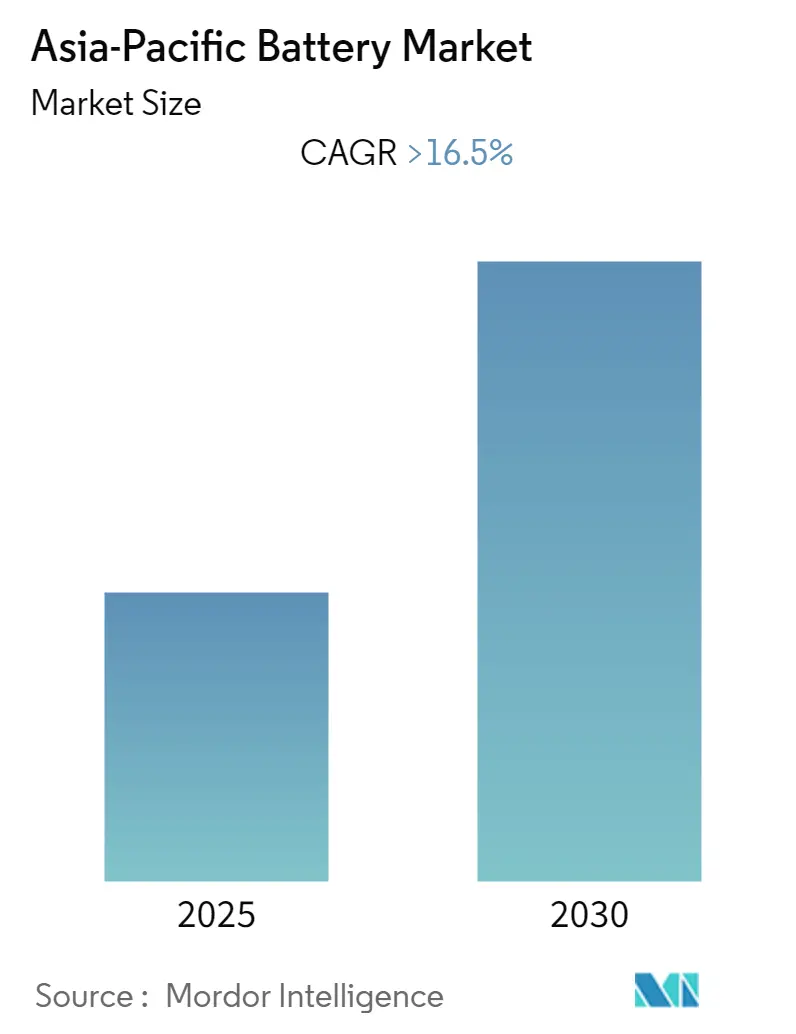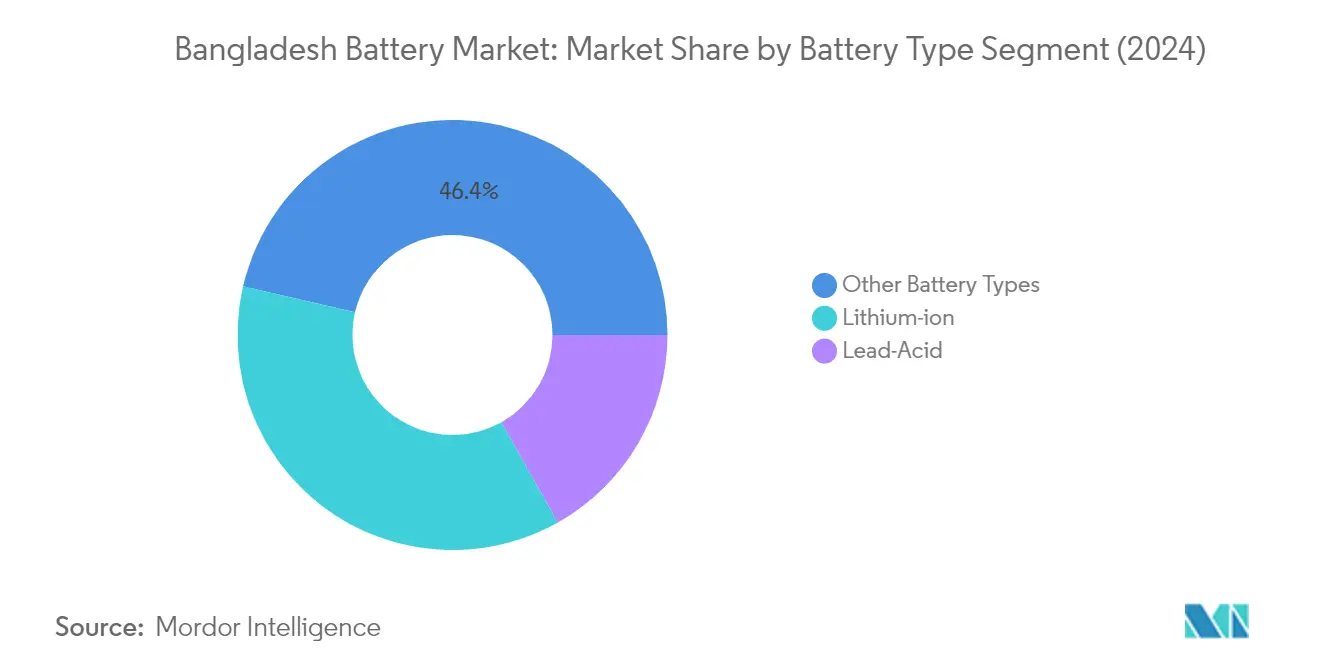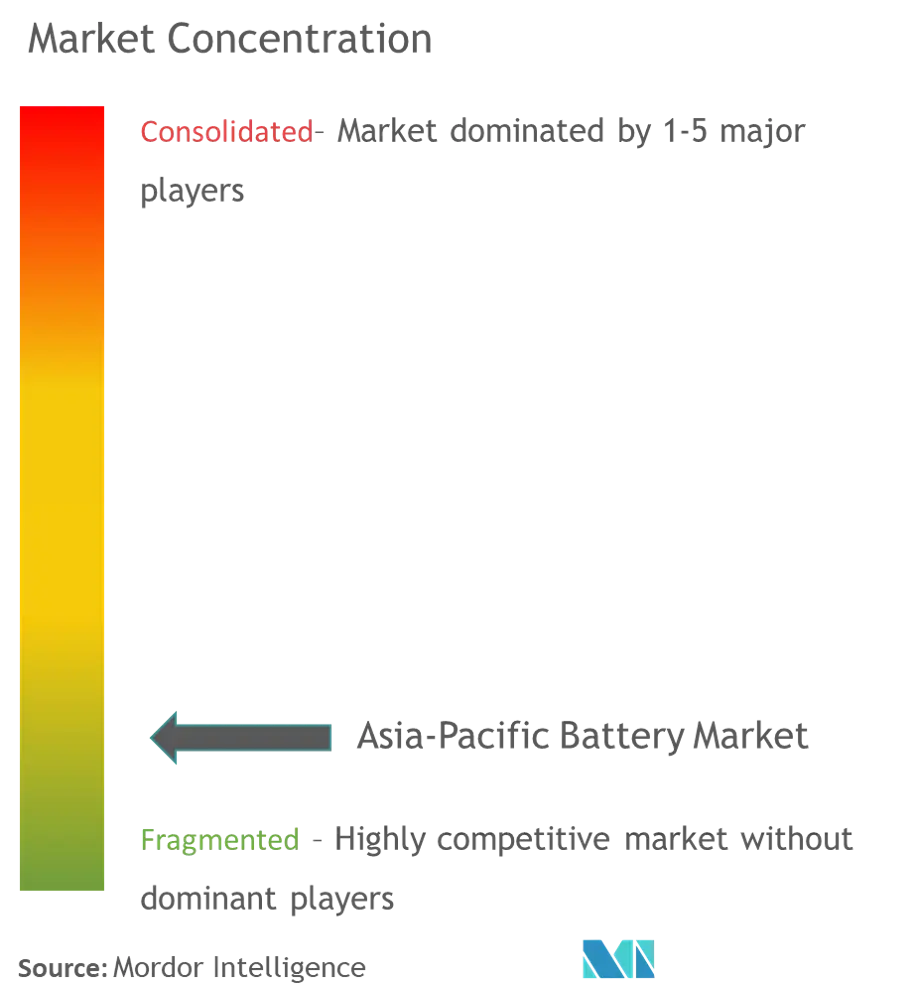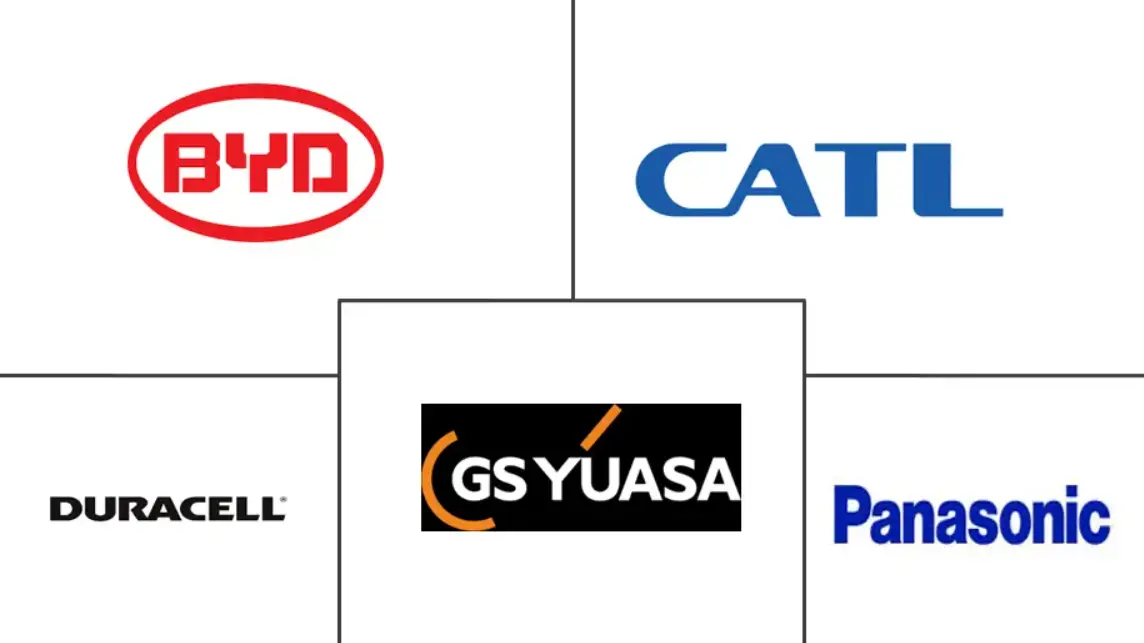
Asia-Pacific Battery Market Analysis by Mordor Intelligence
The Asia-Pacific Battery Market is expected to register a CAGR of greater than 16.5% during the forecast period.
The battery industry in Bangladesh is experiencing significant transformation driven by rapid urbanization and increasing vehicle ownership. As of January 2024, motorcycle registrations reached 25,648 units, reflecting growing demand for personal mobility solutions. This surge in vehicle ownership has created substantial opportunities for battery manufacturers, with several international players entering the market. Notable developments include the inauguration of Bangladesh Honda's motorcycle manufacturing factory in November 2023 and Fair Technology's establishment of a Hyundai manufacturing plant in January 2023, both indicating strong market potential and growing industrial capabilities.
The electric vehicle battery segment is witnessing remarkable evolution, particularly in the three-wheeler sector where approximately 3-4 million vehicles serve a population of 112 million daily. However, the industry faces challenges with battery quality and recycling practices. Current lead-acid batteries for EZ Bikes, costing approximately USD 650 per set, have a relatively short lifespan of 8-11 months, leading to frequent replacement cycles and environmental concerns. The government is actively addressing these issues through comprehensive policy frameworks and infrastructure development, with approximately 20 operational charging stations currently in place and plans for expansion.
The manufacturing landscape is undergoing substantial transformation with significant investments in domestic production capabilities. In September 2023, Bangladesh Auto Industries Limited announced a BDT 1440 crore investment to establish the country's first electric car manufacturing facility in Chattogram. Additionally, in April 2024, Edison Technologies Limited formed a strategic partnership with TAILG GROUP to introduce electric two- and three-wheeler vehicles, demonstrating the market's growing maturity and commitment to sustainable transportation solutions.
The informal battery sector presents both challenges and opportunities, with current practices leading to an estimated USD 91 million in annual tax revenue losses due to unofficial used lead-acid battery (ULAB) recycling. To address this, manufacturers are focusing on developing high-quality, efficient batteries while the government implements stricter regulations and standards. Runner Automobiles has established a significant presence with their factory capable of producing 30,000 units annually, employing 700 workers and representing a substantial step toward formalizing and modernizing the industry. These developments, coupled with increasing environmental awareness and regulatory support, are reshaping the market landscape and driving innovation in battery technology and manufacturing processes.
Asia-Pacific Battery Market Trends and Insights
Growing Electric Vehicle Adoption and Supportive Government Policies
The automotive battery market is experiencing substantial momentum driven by accelerating electric vehicle battery adoption and comprehensive government support mechanisms. In January 2024, the Cabinet Division's committee in Bangladesh outlined an ambitious roadmap that includes tax holidays for local EV manufacturing until 2040, phased customs duty reductions on EV components, and lower registration fees for electric vehicles. The government has also implemented strategic incentives for both importing and locally producing lithium batteries, alongside establishing a robust network of charging stations. This comprehensive policy framework demonstrates the government's commitment to achieving its target of reducing carbon emissions by 3.4 million tonnes and integrating electric vehicles into 30% of its transportation sector by 2030.
The market is further energized by significant investments from both domestic and international players in the EV manufacturing ecosystem. For instance, in April 2024, Edison Technologies Limited announced a pioneering partnership with TAILG GROUP to introduce electric two and three-wheeler vehicles in Bangladesh. Similarly, Bangladesh Auto Industries Limited has committed substantial investments to establish the nation's inaugural electric car manufacturing facility in the Bangabandhu Shilpa Nagar Economic Zone. These developments are complemented by the transport authority's active implementation of EV charging infrastructure, with approximately 20 operational charging stations already in place and ongoing discussions with Korean companies for a USD 10 million project to expand the charging network.
Expanding Telecom Infrastructure and Energy Storage Requirements
The rapid expansion of telecommunication infrastructure has emerged as a significant driver for the battery market, particularly given the critical need for reliable power backup solutions. A notable challenge in the current landscape is that more than 50% of telecom towers are located in sites experiencing power outages for eight or more hours daily, while industry regulations mandate maintaining an uptime of 99.5% to avoid penalties. This operational requirement has created a substantial demand for reliable energy storage battery solutions, pushing telecom operators to transition from traditional diesel generators to more sustainable battery-based backup systems.
The transformation of the telecom sector's power infrastructure is further accelerated by regulatory directives promoting sustainable energy solutions. In February 2020, the Department of Telecommunications issued comprehensive guidelines directing telecom service providers to implement renewable energy solutions and energy-efficient technologies. This regulatory push, combined with the industry's own sustainability goals, has created a strong impetus for the adoption of advanced battery storage systems. The trend is particularly significant as telecom operators seek to optimize their operational costs while meeting environmental compliance requirements, driving innovation in battery technologies that offer improved efficiency and reliability for telecom applications.
Urbanization and Increasing Technology Adoption
The rapid pace of urbanization and increasing technology adoption across various sectors has created a robust demand for rechargeable battery solutions in both consumer and industrial applications. The motorcycle industry serves as a prime example of this trend, with registration numbers reaching 25,648 in January 2024, surpassing the previous year's figures for the same month. This growth is particularly significant in urban areas, where the proliferation of ride-sharing apps has led to a doubling of bike ownership in major cities like Dhaka over the past eight years, with nearly five lakh bike owners in the city alone.
The market is further strengthened by the expanding middle class and their increasing adoption of smart technologies. This is evidenced by the growing trend of regular smartphone replacements and the rising penetration of other electronic devices requiring portable power solutions. The transformation is particularly notable in the commercial sector, where businesses are increasingly integrating smart technologies into their operations, creating additional demand for reliable rechargeable battery solutions. This trend is complemented by government initiatives supporting innovation in the technology sector, including tax incentives and import policies that facilitate the adoption of advanced solar battery technologies across various applications.
Segment Analysis: Battery Type
Lithium-Ion Segment in Bangladesh Battery Market
The lithium battery segment has emerged as a dominant force in Bangladesh's battery market, commanding approximately 37% of the market share in 2024. This significant market position is driven by the increasing adoption of electric vehicles in Bangladesh, particularly in the two-wheeler and three-wheeler segments. The government's commitment to reducing 3.4 million tonnes of CO2 equivalent GHG emissions by 2030 has created a favorable environment for lithium battery adoption. The implementation of various policies, such as the Mujib Climate Prosperity Plan and the Automobile Industry Development Policy 2021, has further strengthened the segment's position. These policies include attractive incentives such as tax benefits for EV manufacturers and assemblers, financial incentives for consumers, and reductions in registration fees, all contributing to the growing demand for lithium-ion batteries in the automotive sector.

Lead-Acid Segment in Bangladesh Battery Market
The lead acid battery segment is projected to experience robust growth with an estimated CAGR of approximately 9% from 2024 to 2029. This growth is primarily driven by the segment's established presence in conventional vehicles and its cost-effectiveness compared to other battery technologies. The expansion of production capacity for two-wheelers and three-wheelers, coupled with initiatives like the Bangladesh Honda Motorcycle Manufacturing Factory, is significantly boosting the demand for lead acid battery solutions. The segment's growth is further supported by the increasing vehicular population, with motorcycle registrations showing strong momentum. The government's implementation of various tax initiatives, import policies, and innovation incentives has created a favorable environment for the growth of the lead-acid battery segment, particularly in the two-wheeler industry.
Remaining Segments in Battery Type Market
Other battery types, including nickel metal hydride batteries, sodium-ion batteries, and flow battery technologies, play a crucial role in Bangladesh's battery market. These technologies are particularly important in hybrid vehicles, with vehicles like Toyota Aqua, Honda Grace, and Nissan X-Trail gaining popularity in Bangladesh. The segment benefits from financial incentives for hybrid vehicles and their advantages, such as higher traveling range and reduced dependency on fossil fuels. The entry of companies like RANCON Holdings Limited and Proton, launching hybrid vehicles in Bangladesh, further supports the growth of these alternative battery technologies. These battery types offer unique advantages in specific applications, contributing to the overall diversification of the battery market in Bangladesh.
Segment Analysis: Application
Three-Wheeler Segment in Asia-Pacific Battery Market
The three-wheeler segment dominates the Asia-Pacific battery market, commanding approximately 56% of the market share in 2024. This significant market position is primarily driven by the extensive presence of electric three-wheelers, including EZ bikes, mishuks, and e-rickshaws, which serve as the primary mode of transportation for millions in Bangladesh, with 3 to 4 million vehicles catering to 112 million people daily. The sector, valued at around USD 871 million, plays a crucial role in providing affordable transport, reducing dependency on fossil fuels, and creating local job opportunities. The popularity of easy bikes has surged due to their lower investment costs, ranging between BDT 1,00,000 and 1,50,000, and significantly lower maintenance and operation costs compared to conventional fuel-powered vehicles. The segment's dominance is further strengthened by recent regulatory support, as evidenced by the April 2024 Supreme Court decision allowing three-wheelers to operate on all roads across Bangladesh, except highways.
Two-Wheeler Segment in Asia-Pacific Battery Market
The two-wheeler segment is emerging as the fastest-growing segment in the Asia-Pacific battery market, with a projected growth rate of approximately 8% from 2024 to 2029. This remarkable growth is fueled by the widespread popularity of ride-sharing apps and the doubling of bike owners in Dhaka over the past eight years. The segment's growth is further accelerated by supportive government initiatives, including the implementation of the Automobile Development Policy 2021, which aims to produce EVs by 2030 and offers special incentive programs such as tax benefits for up to 10 years, financial incentives, purchase incentives, and reduced registration fees. The expansion is also driven by significant investments from major manufacturers, as evidenced by Bangladesh Honda Pvt Ltd's inauguration of their motorcycle manufacturing factory in November 2023, with an investment of approximately 2.3 billion BDT. Additionally, new market entrants like Edison Technologies Limited's partnership with TAILG GROUP in April 2024 and Komaki's expansion into Bangladesh are further stimulating the segment's growth.
Remaining Segments in Application
The passenger car segment, while smaller in market share, plays a vital role in the Asia-Pacific battery market. This segment is experiencing significant developments with the emergence of both conventional and electric vehicles. The market is seeing increased activity with Fair Technology Limited establishing a Hyundai car manufacturing plant at Bangabandhu Hi-Tech Park, and Bangladesh Auto Industries Limited planning the nation's inaugural electric car manufacturing facility. The segment is further supported by government initiatives targeting 30% electric vehicle adoption by 2030, along with various incentives including special registration provisions and tax benefits, indicating a promising future for battery demand in this segment. The growing demand for automotive battery solutions is evident as these developments unfold.
Competitive Landscape
Top Companies in Asia-Pacific Battery Market
The Asia-Pacific battery market is dominated by established players like Rahimafrooz, Exide Industries Limited, Saif Powertec, Amara Raja, and Navana Battery. These companies are driving market growth through continuous product innovation, particularly in lead-acid and lithium-ion battery technologies for automotive battery and industrial applications. Strategic collaborations with global technology providers and local distributors have enhanced their market penetration and operational efficiency. Companies are increasingly focusing on expanding their manufacturing capabilities while simultaneously developing environmentally sustainable battery solutions. The market leaders are also investing in research and development to improve battery performance, longevity, and charging capabilities, especially for electric vehicle applications. Additionally, these companies are strengthening their distribution networks and after-sales service capabilities to maintain a competitive advantage and market leadership.
Market Dominated by Regional Manufacturing Giants
The Asia-Pacific battery market exhibits a mix of well-established global conglomerates and strong regional players, with local manufacturers holding significant market share in Bangladesh and surrounding regions. The market structure is characterized by the presence of vertically integrated companies that control multiple aspects of the value chain, from raw material procurement to distribution networks. Major players are increasingly pursuing strategic partnerships and joint ventures to strengthen their market position, particularly evident in recent collaborations between Chinese automobile companies and local Bangladeshi conglomerates like Akij Group and ACI Motors.
The market shows moderate consolidation with a handful of large players controlling the majority market share, while numerous smaller players operate in specialized segments or regional markets. Merger and acquisition activities are primarily driven by the need to acquire technological capabilities, expand geographic presence, and strengthen distribution networks. Companies like Amara Raja and Exide Industries are actively pursuing expansion strategies in South Asian markets, while international players like EnerSys and GS Yuasa are establishing local partnerships to enhance their market presence.
Innovation and Sustainability Drive Future Growth
Success in the Asia-Pacific battery market increasingly depends on companies' ability to innovate while maintaining cost competitiveness. Market leaders are investing in advanced manufacturing technologies and sustainable production processes to meet evolving regulatory requirements and changing consumer preferences. Companies are also focusing on developing specialized industrial battery solutions for emerging applications in electric vehicles and renewable energy storage battery. The ability to establish a strong local manufacturing presence while maintaining global technology partnerships will be crucial for maintaining a competitive advantage.
For new entrants and smaller players, success will depend on their ability to identify and serve niche market segments while building strong distribution networks. The market presents significant opportunities for companies that can offer innovative financing solutions and after-sales support, particularly in the growing electric vehicle segment. Regulatory support for local manufacturing and environmental regulations favoring cleaner technologies will continue to shape competitive dynamics. Companies that can effectively balance product innovation with cost optimization while maintaining strong relationships with both suppliers and customers will be better positioned for long-term success in this evolving market.
Asia-Pacific Battery Industry Leaders
BYD Co. Ltd
Duracell Inc.
Panasonic Corporation
GS Yuasa Corporation
Contemporary Amperex Technology Co. Limited
- *Disclaimer: Major Players sorted in no particular order

Recent Industry Developments
- January 2022: China Lithium Battery Technology signed two contracts with two cities in the southern Chinese province of Guangdong to build new production facilities with an annual capacity of 50 GWh. The factories will be located in Guangzhou and Jiangmen.
- January 2022: BYD and FAW are planning a production facility for electric car batteries with an annual capacity of 45 GWh in north-eastern China. A joint venture between BYD and FAW called FAW FinDreams New Energy Technology was established, with a registered capital of EUR 140 million. BYD holds 51% of the JV, and FAW Group owns the remaining.
Asia-Pacific Battery Market Report Scope
A battery is an energy source that converts chemical energy into electrical energy consisting of one or two electrochemical cells by means of a redox reaction.
The Asia-Pacific Battery market is segmented by type, technology, application, and geography. The type includes primary battery and secondary battery. By technology type, the market is segmented into lead-acid batteries, lithium-ion batteries, and other technologies. The application consists of automotive batteries (HEV, PHEV, and EV), industrial batteries (motive, stationary (telecom, UPS, and Energy Storage Systems (ESS)), portable batteries (consumer electronics), and other applications. The report also covers the market size and forecasts for the Asia-Pacific Battery market across significant regions or countries. For each segment, the market sizing and forecasts have been done based on installed capacity (Megawatt).
| Primary Battery |
| Secondary Battery |
| Lead-acid Battery |
| Lithium-ion Battery |
| Other Technologies |
| Automotive Batteries (HEV, PHEV, and EV) |
| Industrial Batteries (Motive, Stationary (Telecom, UPS, and Energy Storage Systems (ESS)) |
| Portable Batteries (Consumer Electronics) |
| Other Applications |
| India |
| China |
| Japan |
| South Korea |
| Rest of Asia-Pacific |
| Type | Primary Battery |
| Secondary Battery | |
| Technology | Lead-acid Battery |
| Lithium-ion Battery | |
| Other Technologies | |
| Application | Automotive Batteries (HEV, PHEV, and EV) |
| Industrial Batteries (Motive, Stationary (Telecom, UPS, and Energy Storage Systems (ESS)) | |
| Portable Batteries (Consumer Electronics) | |
| Other Applications | |
| Geography | India |
| China | |
| Japan | |
| South Korea | |
| Rest of Asia-Pacific |
Key Questions Answered in the Report
What is the current Asia-Pacific Battery Market size?
The Asia-Pacific Battery Market is projected to register a CAGR of greater than 16.5% during the forecast period (2025-2030)
Who are the key players in Asia-Pacific Battery Market?
BYD Co. Ltd, Duracell Inc., Panasonic Corporation, GS Yuasa Corporation and Contemporary Amperex Technology Co. Limited are the major companies operating in the Asia-Pacific Battery Market.
What years does this Asia-Pacific Battery Market cover?
The report covers the Asia-Pacific Battery Market historical market size for years: 2021, 2022, 2023 and 2024. The report also forecasts the Asia-Pacific Battery Market size for years: 2025, 2026, 2027, 2028, 2029 and 2030.



